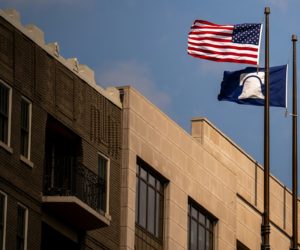Setting aside for now the question, or the argument, of whether we have not enough or too many bayonets, horses and aircraft carriers, and in keeping with a promise to publish from time to time information that confirms that our military remains the most powerful in the world, here is one such bit of information.
Today, as the USS Enterprise (CVN 65), the Navy’s first nuclear-powered aircraft carrier, was inactivated in Norfolk, Va., Secretary of the Navy Ray Mabus announced that the third Gerald R. Ford class aircraft carrier will be named Enterprise in honor of the venerable aircraft carrier that has served sterlingly in peace and in war for more than five decades.
A veteran of 25 deployments to the Mediterranean Sea, Pacific Ocean, and the Middle East, Enterprise has served in nearly every major conflict to take place during her history. From the Cuban Missile Crisis in 1962 to six deployments in support of the Vietnam conflict through the Cold War and the Gulf Wars, Enterprise was there. On September 11, 2001, Enterprise aborted her transit home from a long deployment after the terrorist attacks, and steamed overnight to the North Arabian Sea. Big ‘E’ once again took her place in history when she launched the first strikes in direct support of Operation Enduring Freedom.
Attendees observe the inactivation ceremony of the aircraft carrier USS Enterprise (CVN 65) (U.S. Navy photo by Mass Communication Specialist 3rd Class Zachary S. Welch)
“The USS Enterprise was the first of its kind, and for 51 years its name has been synonymous with boldness, readiness and an adventurous spirit,” said Mabus. “Rarely has our fleet been without a ship bearing the name. I chose to maintain this tradition not solely because of the legacy it invokes, but because the remarkable work of the name Enterprise is not done.”
The future USS Enterprise (CVN 80) will be the third of the new Gerald R. Ford-class aircraft carrier and the ninth Navy ship to bear that name.
The other two Ford-class carriers presently under construction or planned, are the PCU (Pre-Commissioning Unit) Gerald R. Ford (CVN 78) and PCU John F. Kennedy (CVN 79), respectively. Gerald R. Ford (CVN 78) was ordered from Newport News Shipbuilding on Sept. 10, 2008, and is scheduled to be delivered in 2015.
According to the Navy:
The Gerald R. Ford class will be the premier forward asset for crisis response and early decisive striking power in a major combat operation. Gerald R. Ford class aircraft carriers and carrier strike groups will provide the core capabilities of forward presence, deterrence, sea control, power projection, maritime security and humanitarian assistance. The class brings improved war fighting capability, quality of life improvements for our Sailors and reduced acquisition and life cycle costs.
Each ship in the new class will save $4 billion in total ownership costs during its 50-year service life, compared to the Nimitz-class. For comparison, the total ownership cost for a Nimitz-class ship is $39.2 billion in FY 12 constant year dollars, and the total ownership cost for CVN 78 is expected to be $35.6 billion. Half of the total ownership cost for an aircraft carrier is allocated to the direct and indirect costs of manpower for operations and maintenance of the ship. The CVN 78 is being designed to operate effectively with nearly 800 fewer crew members than a CVN 68-class ship. Improvements in the ship design will allow the embarked air wing to operate with 663 fewer personnel…
Chief of Naval Operations (CNO) Adm. Jonathan Greenert tours the aircraft carrier Pre-Commissioning Unit (PCU) Gerald R. Ford (CVN 78) to personally see the construction efforts of the newest class of nuclear-powered, super carrier while at the Newport News Shipbuilding shipyard. (U.S. Navy photo by Mass Communication Specialist 1st Class Peter D. Lawlor)
Gerald R. Ford is the first aircraft carrier designed with all electric utilities, eliminating steam service lines from the ship, reducing maintenance requirements and improving corrosion control efforts…The Gerald R. Ford class is designed to maximize the striking power of the embarked carrier air wing. The ship’s systems and configuration are optimized to maximize the sortie generation rate (SGR) of attached strike aircraft, resulting in a 25 percent increase in SGR over the Nimitz class…
These are the general characteristics of the Gerald R. Ford class :
Builder: Huntington Ingalls Industries Newport News Shipbuilding, Newport News, Va.
Propulsion: Two nuclear reactors, four shafts.
Length: 1,092 feet
Beam: 134 feet, Flight Deck Width: 256 feet.
Displacement: approximately 100,000 long tons full load.
Speed: 30+ knots (34.5+ miles per hour)
Crew: 4,539 (ship, air wing and staff).
Armament: Evolved Sea Sparrow Missile, Rolling Airframe Missile, CIWS.
Aircraft: 75+.
No horses and bayonets here…
Sources: U.S. Navy
All photos and captions: U.S.Navy




















